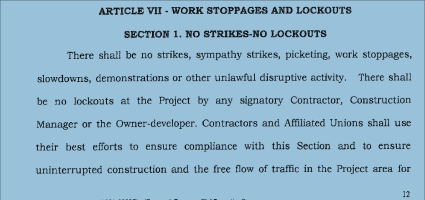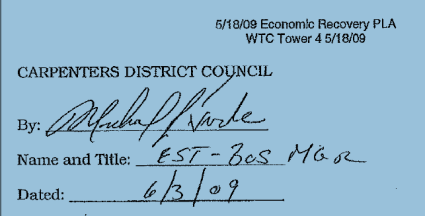NYC Union Strike Shuts Down Project Labor Agreement Jobsites Again
Earlier this month, New York City jobsites were shut down after unions failed to honor their project labor agreement’s (PLA) no-strike promise. It is at least the third time since 2011 various NYC unions blatantly violated no-strike provisions in controversial PLAs, which steer construction contracts to unionized contractors and provide jobs exclusively for union members in exchange for a prohibition against union strikes and disruptions on covered jobsites.
On Monday, July 1, 2015, members of the New York City District Council of Carpenters walked off up to 20 job sites in a strike after contracts between the union and the Cement League, as well as the Building Contractors Association and the Contractors’ Association of Greater New York expired June 30.

The New York Post reported that at least 12 of the projects were subject to PLAs and a federal judge ordered the union promise-breakers to get back to work on July 6 (“Judge orders city carpenters union back to work,” 7/6/15):
A federal judge has ordered a city carpenters union to get back to work by Monday, after members walked off job sites in violation of several labor agreements.
The New York City District Council of Carpenters began striking Wednesday at up to 20 sites after contract negotiations with the Cement League, a collective of unionized contractors, fell through.
At 12 of those sites — including Hudson Yards and World Trade Center 3 — project labor agreements forbid such stoppages.
Saturday, those deals and a petition from the Cement League led federal Judge Edgardo Ramos to issue a temporary restraining order instructing the union to have its members return to work.
Cement League director Michael Salgo described the strike as “frustrating and distressing,” noting that the absence of anywhere between 360 and 500 carpenters has cost builders millions of dollars in delays.
A source in another New York Post article expressed their disgust with this costly strike and promise-breaking (“Crews, carpenters leave their jobs in city-wide walk-off,” 7/3/15) :
“The carpenters are making a mockery over the project labor agreements,” said Paul Salvatore, a spokesman for the Cement League.
Another Cement League executive expressed similar sentiments to Capital New York (“Talks to resume in Hudson Yards strike,” 7/6/15):
“For those of us who are trying to promote union work, the actions of the District Council of Carpenters is frustrating and distressing,” said Michael Salgo, executive director of the Cement League, the association representing unionized concrete contractors, who are at odds with the workers over their compensation packages. [snip]
“At a time when union contractors are losing more and more market share to their non-union counterparts, for the carpenters union to stage illegal strikes on union sites where they had explicitly promised not to take such job actions sends the wrong message altogether,” he added.
According to Real Estate Weekly, the strike comes on the heels of government-mandated PLAs on $8 billion worth of NYC construction work (“Judge points to PLA in ordering union workers to end strike,” 7/6/15):
Two weeks ago, New York City Mayor Bill de Blasio announced a new deal on PLAs that he claims will save the city more than $347 million and create opportunities for companies owned by women and minorities. The agreement, which involves the Building and Construction Trades Council of Greater New York, will cover about $8 billion worth of projects for its duration.
Brian Sampson, the president of the Empire State chapter of Associated Builders and Contractors, disputed the mayor’s claims, saying: “While there is little doubt in my mind that these numbers are inaccurate and based on best case scenarios, were it in fact true, it would contradict numerous studies of major projects that have shown that PLAs add huge amounts onto construction costs.”
Strikes on construction projects subject to PLAs violate provisions contained in typical PLAs that allegedly prevent strikes, walkouts and other labor disputes—calling into question the value of these anti-competitive and costly schemes.
Given poor outcomes like this, why do lawmakers continue to mandate PLAs on taxpayer-funded projects? Politics, of course.
The PLA Hustle
In order to create more jobs for union members and increase the unionized sector’s dwindling market share, union bosses market PLAs to lawmakers and private construction owners as a tool to guarantee quality, safety and labor peace on construction projects in exchange for a requirement by owners to exclusively use contractors that agree to be bound by the union-friendly terms and conditions of a PLA.
Big Labor bosses load PLAs with language favorable to union leaders, union members and unionized contractors hand-picked to receive preferential treatment by a PLA.
These agreements typically force contractors to hire all or most of their tradespeople from union hiring halls, pay into union pension and benefit plans, follow inefficient union work rules, and hire apprentices exclusively from union apprenticeship programs. As a condition of working on a PLA project, provisions in typical PLAs also can force nonunion employees to:
- join a union or receive unwanted union representation;
- follow archaic work rules;
- pay union dues and initiation fees; and
- forfeit any employer and employee contributions to union benefit plans unless they join a union and become vested in these plans.
Naturally, these provisions discourage competition from qualified nonunion contractors and their skilled employees.
Costly union rules and less competition results in increased costs. Research across the country, including a study on the impact of PLAs on school construction in New York, has found PLAs increase the cost of construction between 12 percent and 18 percent compared to similar non-PLA projects.
For years, even Big Labor bosses have admitted that a PLA’s promise to prevent strikes and labor unrest is often broken, resulting in the potential for lost market share for union contractors.
For example, Joseph Hunt, president of the Ironworkers Union, devoted his President’s Page column (“Ironworkers Have Tradition and Honor in Project Labor Agreements“) in the February 2008 edition of The Ironworker to inform Ironworkers union members that:
“Once again, it is my duty to inform you there has been an increase in work stoppages on jobs governed by project labor agreements.”
“A No Work Stoppage-No Lock Out clause is the most important because it is the foremost reason owners and contractors are willing to use the agreement [a PLA] to commit to an all-union job.”
“They [owners] have a choice and they know that the non-union do not have jurisdictional disputers nor do they have strikes.”
Lawmakers know PLAs often fail to deliver on promises but look the other way because they fear the spigot of union political contributions and support will be turned off if they oppose these backroom deals. They defend PLAs by claiming these agreements, despite their imperfections, lead to safer jobsites and better local hiring outcomes (but this isn’t always the case, either, as demonstrated in the hyperlinks).
The Value of PLAs on Display?
In the summer of 2011, a strike and walkout by NYC concrete union laborers impacted the following NYC PLA projects: Weill Cornell Medical Center, the Barclays Center at Atlantic Yards in Brooklyn, Madison Square Garden, World Trade Center Tower 2 and Extell Development’s Carnegie 57 luxury hotel and high-rise project across from Carnegie Hall on West 57th Street.
In July of 2013, another strike and walkout by NYC Carpenters Local 2790 shut down the World Trade Center 4 jobsite and a number of projects in the tri-state area.
The 4 World Trade Center jobsite suffered a crane accident in February 2012. In August 2012, the New York Post reported the Port Authority cracked down on drinking by construction union members following a series of accidents and reports of excessive workday boozing by union tradespeople employed at various World Trade Center construction projects, including 4 World Trade Center (“Construction Union Booze Crews Targeted for Drinking on PLA-Covered Ground Zero Projects,” 9/10/12).
With workplace alcohol abuse, accidents and strikes plaguing high-profile NYC construction projects like Hudson Yards and World Trade Center properties for the past five years, clearly NYC PLAs have a well-earned reputation for poor performance.
Is this the value of PLAs on display?
Learn more about PLAs failing to prevent strikes on projects across the country here.














